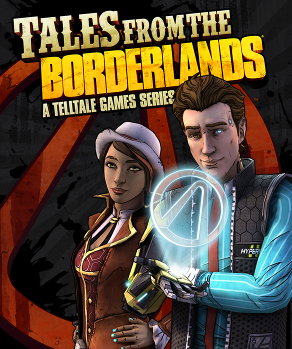
I have to say, my favorite part of these Tales from the Borderlands episodes are the freeze-frame opening credits, usually showing up after a cold open that lets them pause an action scene or a montage of still images as they move around the space with the various credits superimposed. Kinda like how that Deadpool movie opens, just without Juice Newton's "Angel of the Morning". It makes me wish I was better at introducing my own material. Here goes: I played more of this episodic adventure game about the Borderlands and the people in the Borderlands opening a vault. In the Borderlands.
The game's action-sequences have this odd combination of interactivity and pre-planned choreography, the issue that QTEs were invented to normalize in a video game context all the way back with Dragon's Lair, where you were only ever presented with the Hobson's choice of getting the buttons right or failing in a humorously morbid "dead end" (literally, in most cases) and being forced to try again from a few moments back. I think at their best QTEs are meant to provide the illusion that the player is in charge of the movie playing out, and there are definitely times where I find myself drawn in by the artifice. When an indicator appears that demands you tap a button quickly to win a tug of war or crawl through a closing door, it's hard not to get swept up in the moment and start hammering the poor controller. On the other hand, this illusion gets more and more strained the more it gets invoked. I realize Telltale's oeuvre has failure states that go beyond your protagonist getting themselves killed and forcing a restart, which is to say consequences that will stick around for the rest of the game, and yet it's hard to take each batch of the same context-based QTEs seriously. It eventually begins to feel like certain actions are conceived based on the QTE prompt that will pop up to resolve them, rather than the ideal vice versa.
In TftB's case in particular, however, its meta sense of humor continues to mitigate a lot of this annoyance over contrivances. After spending the whole game hitting left and right to avoid danger in time, one instance near the end of the third episode has an antagonist aiming a gun at you and a prompt appears for you to reflexively roll to one side. He then berates you for expecting to out-roll a bullet, especially as he simply needs to adjust his aim slightly to the side in order to hit you. Of course, there is a sequence just a few moments later where you do exactly that once again with another protagonist/antagonist combo, so whether there were two people writing this script or the game trying to have its Vault and open it too is a contradiction I'm unable to explain away.
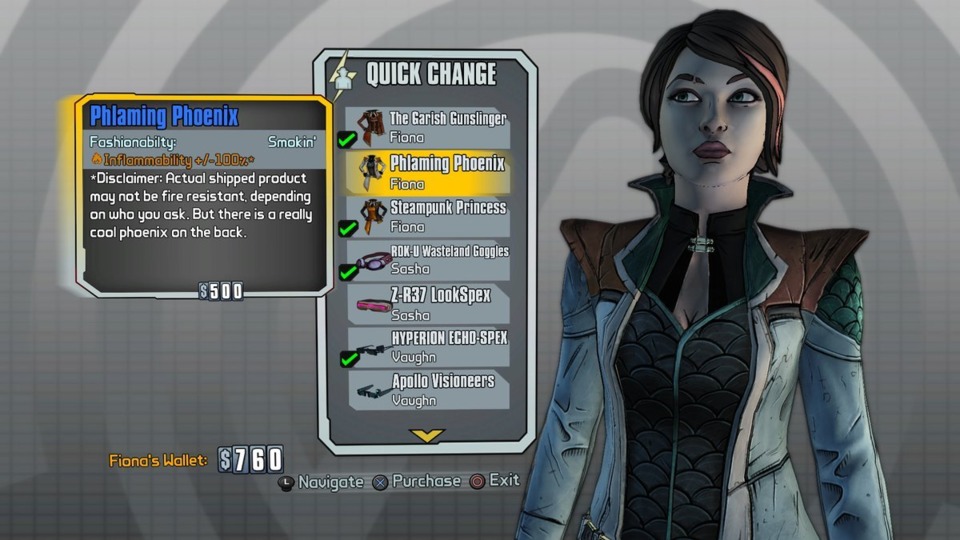
The technical issues, too, are starting to make themselves a little more pronounced. I heard this was one of the major issues people have with Telltale games as a whole, as they continue to tax their extant engine as their stories and action sequences continue to make outlandish demands from it. There's a keen sense that the writing in these games - which is usually pretty excellent - is stifled by the format, in much the same way it might be a traditional adventure game that requires the game pause its narrative flow to give players a puzzle to solve in order to progress (figuratively, in an old point and click graphic adventure; literally, in the case of Professor Layton). I've seen how relying on the same engine game after game can be a problem in other long-running series, most notably Assassin's Creed, where the company's money people erroneously feel that the cheap option of a recycled engine is perfectly capable of handling every new instance or idea the writers and designers can throw at it. What often happens instead is that the engine buckles under the weight of feature creep, and we see lots of bugs and systems that aren't working like they're meant to.
I can give you one instance of this type of bug early on in the third chapter of Tales from the Borderlands. There's a sequence where you're moving down a hall with Rhys and Fiona while a turret vacillates on its automatic path, the idea being to move ahead when the turret's momentarily paused at the terminus of its horizontal sweep and is facing away from you. Rhys is in front of Fiona, so every time you say to "go!" as the latter, he moves one space ahead and Fiona occupies the space he was just in. He reaches the room at the end first and gets jumped by a goon, and suddenly there's a time limit for Fiona to get past the turret and charge in there to save him. Apparently, there was another sudden prompt as she moves into the room to complete the rescue, and I missed it: however, instead of seeing a failure scene, I was unceremoniously booted back to the beginning of the hallway sequence, only now Rhys was already going mano-a-mano with his bandit attacker in the next chamber. Every time I told him to "go", he'd suddenly switch back to moving from behind a crate, before warping ahead to the next room to get back to his struggle. Took a moment to figure out what was even happening. That was a major "uh-oh", but the game is filled with so many minor animation and scene transition bugs that, while it doesn't really hurt the gameplay too much, often serves to break the immersion. Considering how much stock the game puts in railroading you forward through carefully choreographed action scenes, immersion's one of the few strengths a cinematic approach like that has.
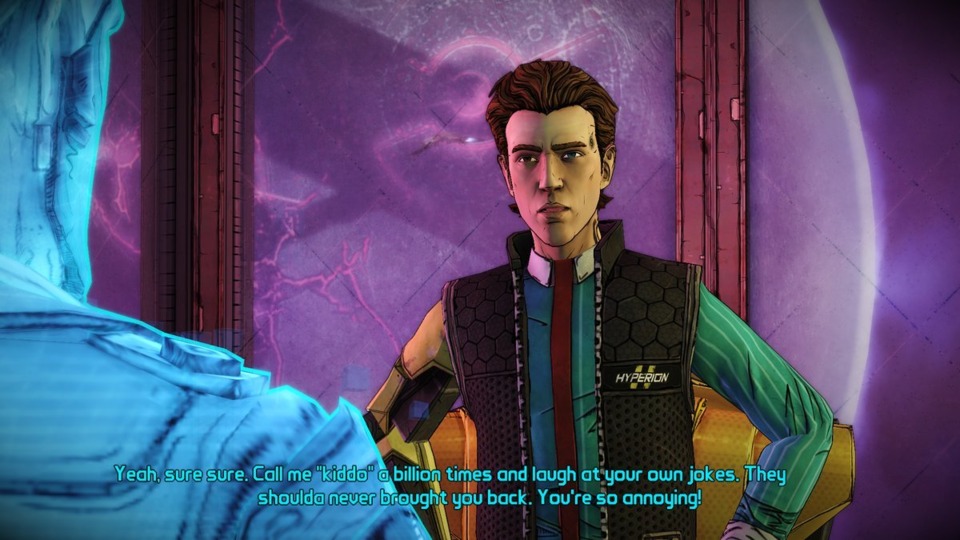
But you know what? I'm still enjoying this game. For as much as Telltale's particular format tends to irk me, it's one of several delivery methods modern adventure games are figuring out how to tell stories, and I figure the more of those we have the better. Narrative-focused games are starting to open up in a lot of interesting ways, with varying degrees of interactivity, and it's been curious to watch how storytellers approach the video game medium with as much or as little traditional gameplay elements as they feel are necessary. Scott Benson, co-creator of Night in the Woods, tweeted something obvious about narrative-focused video games that didn't occur to me until that moment, in that video game storytellers don't actually choose video games as the medium for a story they have in mind, but instead conceive stories for the medium they know best; a small but important distinction. It's telling that we don't really have a whole lot in the way of a "video game screenwriter" role, because in order to effectively tell a story in a video game you need the expertise to know how video games are conceived and directed. A movie or TV screenwriter prospers more when they have a keen sense of cinematography and on-screen aspects like mise en scène that would benefit a tale told in that predominantly visual medium, and with video games all of those visual standards apply and more besides. I don't mean to get off on a tangent here - we're getting a lot of hot takes based on a certain video game critic's latest article on the purpose of stories within video games, and I don't mean to add to that maelstrom when I've clarified my own position in many previous pieces I've written on off-beat adventure games like this. I do think we're on the cusp of finally figuring it out, however, or at least closer to the epiphany that there's a surprisingly varied amount of ways to effectively tell a story within an interactive format.
So yes, I will continue to cover this game for one more of these "Indie Game of the Week" articles at least. I have an idea about how I might supplement the rundown for the last episode, since it's only going to be half as long otherwise. For now, four episodes in, I can continue to recommend this game as a decent realization of this universe and its madcap gallows humor sensibility without necessarily having it revolve entirely around loot RPG gunplay and obnoxious memes.
(We're once again spoiler-blocking these individual episode recaps for the sake of those who have yet to complete them. Oh, and you can catch up with my thoughts/choices on the previous episodes over here.)
Episode 3: Catch a Ride
We'll be back with the Episode 4 rundown... right now.
Episode 4: Escape Plan Bravo
That'll do it for this week. I'll be back soon to polish off Tales from the Borderlands's fifth and final episode in another IGotW update sometime in May. Be sure to mark your own spoilers in the comments if you have something to add or want to talk about the decisions you made. I'm clearly drifting further and further away from the vox populi, so I'd like to see some rationales from others.
| < Back to 16: Severed | > Forward to 18: Song of the Deep |
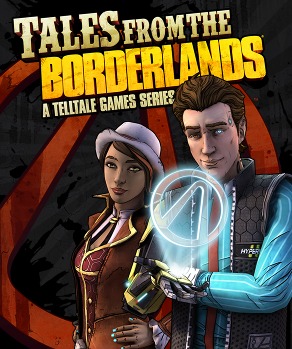
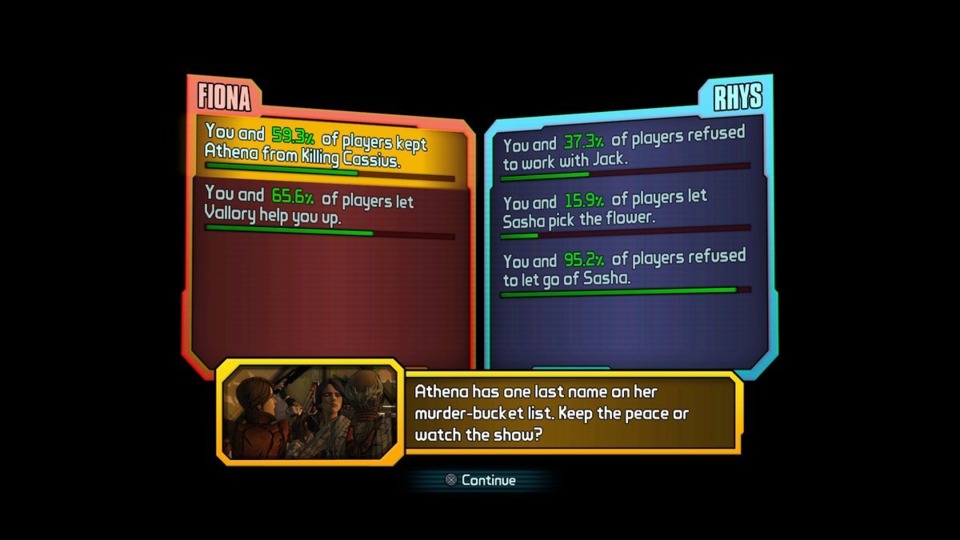

Log in to comment